Text

Australian Brushturkey (Alectura lathami), family Megapodidae, Eastern Australia
Photograph by Jan Wegener
2K notes
·
View notes
Text

[447/10,977] Australian Brushturkey - Alectura lathami
Order: Galliformes Family: Megapodiidae (megapodes)
Photo credit: J J Harrison
125 notes
·
View notes
Text
Australian Brushturkey (Alectura lathami)
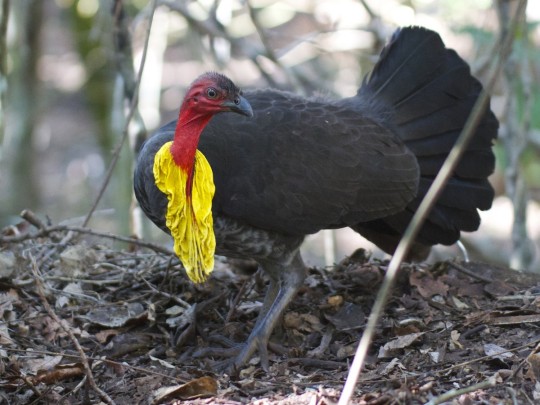
"They make huge piles of leaves and branches as nests. Once I saw a solitary male in a wildlife park and the keepers said he was really annoying because he kept re-arranging the leaf litter which made keeping the footpaths clean a huge pain lol!" "Small gardener-dinosaurs! And these guys are just out here existing with zero parental care."
"Despite its name and their superficial similarities, the bird is not closely related to American turkeys, nor to the Australian bustard, which is also known as the bush turkey."
Australian Brushturkey are a megapode found on the Eastern edge of Australia, typically living in rainforests or wet sclerophyll (eucalyptus-heavy) forests- though they've more recently been moving into cities such as Brisbane and Sydney.
As megapodes, the most unique feature of these birds is the way they incubate and "raise" their young- which is to say, they don't raise them at all! Megapodes are a family of birds that create mounds of rotting vegetation for their eggs to incubate within, much like crocodiles and alligators. The males will tirelessly defend their mounds, checking the temperature with their bills and doing their best to attract females to lay her eggs within. This is the only care they give their young, however. Brushturkey eggs are quite large, and their chicks are born precocial, or "fully developed". Unlike other precocial species, like chickens or ducks, megapode babies can fend for themselves within hours of hatching, and don't need parental guidance in order to make it in the world. Which is good news, since mom invests no care in her young and dad is only concerned with keeping his nest mound in perfect condition!
Sources:
Image Source: eBird (Chris Barnes)
#Alectura lathami#Australian brushturkey#Gweela#megapode#australian wildlife#Australian birds#megapodiidae#in memoriam (joke)
8 notes
·
View notes
Photo
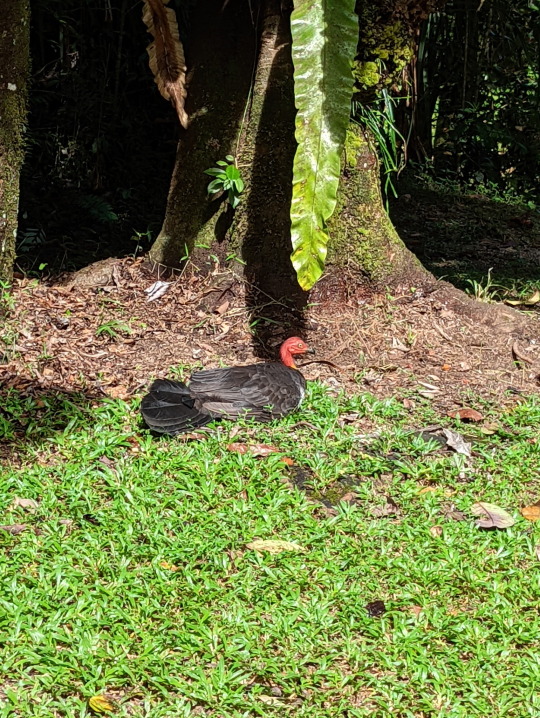

Bush Turkey Enjoying the Sun
You can really see the chicken resemblance here.
Alectura lathami
06/07/22
#Alectura lathami#Australian Brush-Turkey#Galliformes#Landfowl#Aves#Birds#Chordata#Chordates#Vertebrata#Vertebrates#birblr#birdlr#gifs
19 notes
·
View notes
Text

Gobble, gobble? Here’s a turkey you might not be familiar with: the Australian Brush-turkey (Alectura lathami)! Found in parts of eastern Australia, this ground-dwelling omnivore feeds on insects, fallen fruits, and seeds. This species' chicks become independent almost immediately after birth. Parents leave their offspring to fend for themselves, and hatchlings are able to fly within hours of being born. Nearly hunted to extinction in the 1930s, this species’ population has since rebounded.
Photo: JJ Harrison, CC BY 3.0, Wikimedia Commons
#science#amnh#nature#natural history#animals#turkey#thanksgiving#fun facts#fact of the day#did you know#ornithology#birds#australia#gobble gobble
455 notes
·
View notes
Text
Uncharismatic Fact of the Day
Sea turtles are famous for the perilous way they start their lives, but they're not the only ones that face peril from day one. Australian bushturkey chicks have to dig themselves out of their nest, which is usually 1-1.5 m (3.2-4.9 ft) deep, and are capable of flight only a few hours after emerging! This is an important skill to pick up quick, as most predators find the idea of a defenseless baby bird too good an opportunity to pass up; only 1 in every 200 eggs laid survives to adulthood.

(Image: A tasty snack Australian bushturkey chick (Alectura lathami) by Dr. John Martin)
If you like what I do, consider leaving a tip or buying me a kofi!
#Australian bushturkey#Galliformes#Megapodiidae#megapodes#incubator birds#game birds#game fowl#birds#uncharismatic facts
175 notes
·
View notes
Text

WASTE
sci-fi ▼ cyberpunk ▼ synthwave/neo-80s queer rep ▼ disability ▼ mental illness abuse ▼ addiction/recovery Darkspace Portent Series spin-off ▼ takes place before Thriving: Rebirth
▷ Guetry Sympa is a livewire and an adrenaline junkie, a musically talented hero with lawful blindness, so having a government-funded AI implanted in his brain to control most of his bodily systems after nearly dying isn't exactly an easy adjustment to make.
▷ Of course, there's no better way to cope with a hard breakup and recover from a five-month-long coma than by being forced by the Consortium to enlist a team of fellow contract agents for a covert operation...
▷ ...To solve a centuries-old cold case involving the mysterious disappearance of the Milky Way's enigmatic savior.
Playlist: Precious Gems and Reaver Rock

GUETRY DANON SYMPA ▼ French-American ▼ scorpio ▼ human ▼ Earth ▼ a gifted musician and elite member of a special forces task unit working for the Consortium, aided by an AI in his brain that keeps his quality of life ideal after an overdose that left him otherwise brain-dead for five months. wise-cracking smartass unafraid to tear the system apart for what's right.
SUBCUTANEOUS OPERATIONAL and TACTICAL SYSTEM (SCOT) ▼ "Scotty" ▼ artificial intelligence ▼ NodeSource ▼ prototype embedded in Guetry's brain to undo most of the damage from his overdose and keep him functional. added benefits of enhancing his eyesight and aim, providing intel on missions, and overall companionship.
ALECTURA WU ▼ Chinese ▼ aquarius(?) ▼ human ▼ Consortium Node ▼ talented spaceship mechanic and other half of the band Skywaste, co-founded by Guetry when both were in high school. doesn't like going out into the field, will also fight tooth and nail for justice where there is none.
OREN ALTAVIAN ▼ capricorn ▼ human ▼ the Himalaya ▼ self-proclaimed "entrepreneur of seedydom" and known around the Milky Way as the "Kingpin of the Node." slings the hard stuff around the galaxy and gets paid handsomely for it. endlessly charming but willfully manipulative. tends to get his way no matter what, especially at the expense of those around him who think they care for him.
ADAM "MERCURY'' LYONS ▼ scorpio ▼ human ▼ Earth ▼ also an operative for the Consortium with his identical twin sister Quincy "Mars" Lyons. a bit more by the book, but willing to do what's right even if it means risking his job. a fiery complement and challenge for Guetry both personally and professionally.
TUXTH ▼ Rotangan ▼ Logoryt ▼ a child of a Rotangan and a biracial Rontangan/Morrite, born on the seedy planet of Logoryt. in order to combat the rough upbringing she endured, she makes a name for herself by taking on missions for the Consortium, doing her part to chip away at the Morrite Blue Prince Hyret's goal to completely overrun the Milky Way.
DAZIA FOURTEEN ▼ sagittarius(?) ▼ human ▼ Consortium Node ▼ it's unknown what Dazia's origins are other than her birthplace of the Node, though it's alleged that she's of Hispanic, Slavic, and Middle Eastern descent. used to work for Consortium security until she witnessed corrupt activity within the ranks. tough as nails but all heart.

A soft tone swirling in the waves of dark gray and flashes I couldn't decipher. Purple pulsing light. A haze, more flashing images. White lights, gloves, whirring, thumping, squashing. Hot white stars. Burnt umber pain. Scorching pink fire. Numbness in muted blue. Sparking stings. Another soft tone. A smooth yet mechanical voice right inside both of my ears at once. Hello, Guetry. I am your Subcutaneous Operational and Tactical system. What. You have suffered a great deal of neurological damage and I am going to attempt to repair as much as I can. Your next of kin has given full consent to this procedure. The fuck. I am only a prototype as of yet so I must be transparent...there may be some functions I cannot fully restore, but I will do my best to make sure you are healed well enough to wake up and are able to do the remaining recovery yourself. Is this.
14 notes
·
View notes
Text
24th of July 2024: Australian Brushturkey
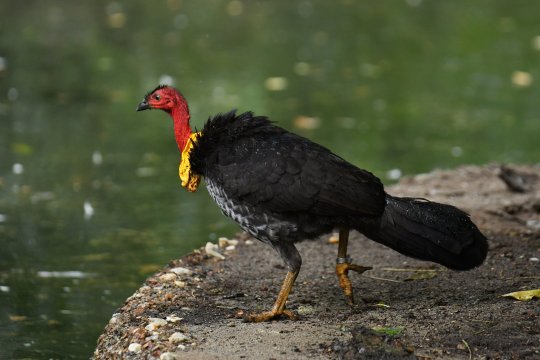
Here is a bird once described as an “enigmatic urban coloniser” [1]: the Australian Brushturkey (Alectura lathami). They’re one of Australia’s three megapodes and are 60-75 cm long [2].
Like many megapodes, they too do ground-nesting, brooding 50 eggs in a mound [2]. These mounds are prepared by the males, who may move up to 50 kg of earth daily to construct their nests [3], which are around 4m in diameter and 1 m high [2]. Once in place, Australian Brushturkeys follow a non-monogamous mating structure, wherein females will go from nest to nest to breed with the males and lay eggs in their mounds. This means the eggs of a previous male may end up in wrong nest, however it appears the males don’t really mind that much. In fact one male was even recorded taking over the mound of a deceased male without destroying any of the pre-existing eggs [4].
The male then broods the eggs for 49 days, maintaining a comfy temperature of around 35°C, using the heat given up by rotting plant matter [2]. Once the eggs hatch, the father fucks off and leaves the hatchlings to fend on their own. However, they are very mobile and can fly a few hours after hatching. In certain skills, such as ledge climbing they get worse as they age [3]. They also have innate responses to different types of predators, but this mostly seems to be connected to their size and positioning as opposed to recognising the specific animal (as cardboard controls also affected them similarly) [5].
After dispersing, Australian Brushturkey chicks prefer thicket to open forest, as these provide more cover to them [6]. In the night, they’ll go up high into the trees to roost [7]. Strangely enough though, in recent times they’ve been found more and more in urban settings, and while most seem to stay around the same area, some may travel up to 37 km, which would contradict the narrative of them being attached to specific sites and habitats [1].
Sources:
[1] [2] [3] [4] [5] [6] [7] [Image]
3 notes
·
View notes
Text









223) Alectura lathami; Nogal brunatny, Australian brushturkey, Australian brush-turkey, gweela, scrub turkey, bush turkey - gatunek dużego ptaka z rodziny nogali (Megapodiidae). Jest jedynym przedstawicielem rodzaju Alectura. Wyróżniono dwa podgatunki A. lathami:
nogal różowoszyi (A. lathami purpureicollis) – północno-wschodni Queensland
nogal brunatny (A. lathami lathami) – wschodnia Australia.
Nogal brunatny występuje we wschodniej i północno-wschodniej Australii. Najczęściej są to wilgotne lasy, zarośla, ale również zaniedbane ogrody. Można je również znaleźć w pobliżu miast na wschodnim wybrzeżu kontynentu.
Nogal brunatny jest gatunkiem osiadłym zamieszkującym lasy tropikalne bądź lasy strefy umiarkowanej ciepłej. Prowadzi naziemny tryb życia, spędza dni na poszukiwaniu pożywienia na łąkach, pastwiskach oraz w podszycie lasu. Dziób przystosowany jest do dziobania materiału roślinnego, ale może również odżywiać się pokarmem zwierzęcym, np. termitami. Silne nogi oraz dobrze rozwinięte stopy przystosowanie są do grzebania w ziemi w poszukiwaniu pożywienia. Nogal brunatny odżywia się owadami i ich larwami, bezkręgowcami, nasionami, jagodami oraz owocami.
Brak znacznego znaczenia dla gospodarki globalnej. Dla mieszkańców rejonów, na których żyje nogal brunatny, jaja tego gatunku są przysmakiem lokalnym. Zbyt duże zagęszczenie gatunku Alectura lathami powoduje znaczną redukcję masy ściółki leśnej oraz gęstości nasion sadzonek. Nogal brunatny nie jest gatunkiem zagrożonym (według IUCN ma status najmniejszej troski – LC), ale jego liczebność cały czas spada.
0 notes
Text
#NowPlaying: "Premiere: Tijuana Cartel - Alectura - Beat & Path" by Electronic Groove
0 notes
Photo
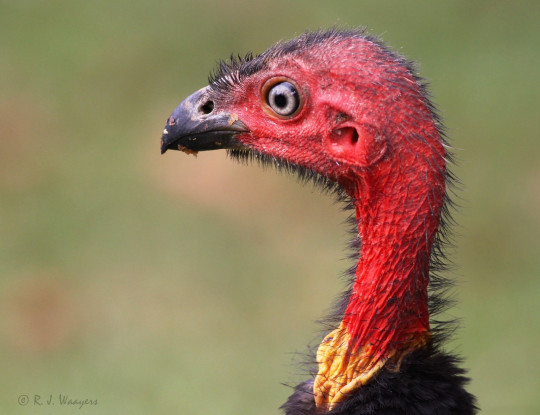
Australian brushturkey (Alectura lathami)
Photo by Robyn Waayers
#fave#australian brushturkey#gweela#alectura lathami#alectura#alecturini#megapodiidae#galliformes#galloanserae#neognathae#aves#theropoda#archosauria#sauropsida#reptilia#tetrapoda#vertebrata#chordata
58 notes
·
View notes
Text
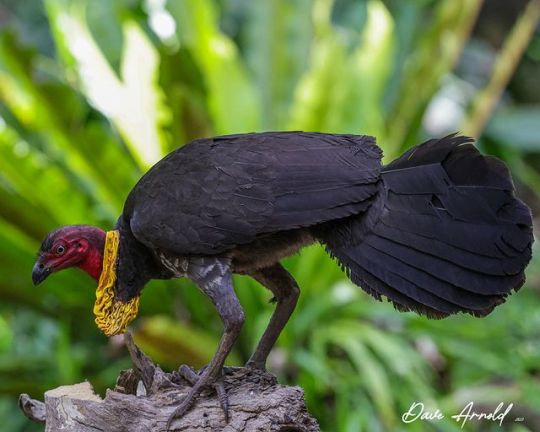
Australian Brushturkey (Alectura lathami), family Megapodidae, order Galliformes, QLD, Australia
Photograph by Dave Arnold
421 notes
·
View notes
Note
I have been collecting birds with common names that have the word 'turkey' in them as I just think they are neat. So far I have
Bush turkey (Alectura lathami) Wild turkey (Meleagris gallopavo) (and all its variations) Ocellated turkey (Meleagris ocellata) Turkey vulture (Cathartes aura) do you know of any others?
The brushturkeys!
These are all the ones I have in my list:
Australian brushturkey - Alectura lathami Black-billed brushturkey - Talegalla fuscirostris Red-billed brushturkey - Talegalla cuvieri Collared brushturkey - Talegalla jobiensis Waigeo brushturkey - Aepypodius bruijnii Wattled brushturkey - Aepypodius arfakianus Ocellated turkey - Meleagris ocellata Wild turkey - Meleagris gallopavo Turkey vulture - Cathartes aura
12 notes
·
View notes
Text
The biggest and slowest don't always bite it first
The biggest and slowest don’t always bite it first
For many years I’ve been interested in modelling the extinction dynamics of megafauna. Apart from co-authoring a few demographically simplified (or largely demographically free) models about how megafauna species could have gone extinct, I have never really tried to capture the full nuances of long-extinct species within a fully structured demographic framework. That is, until now. But how do…
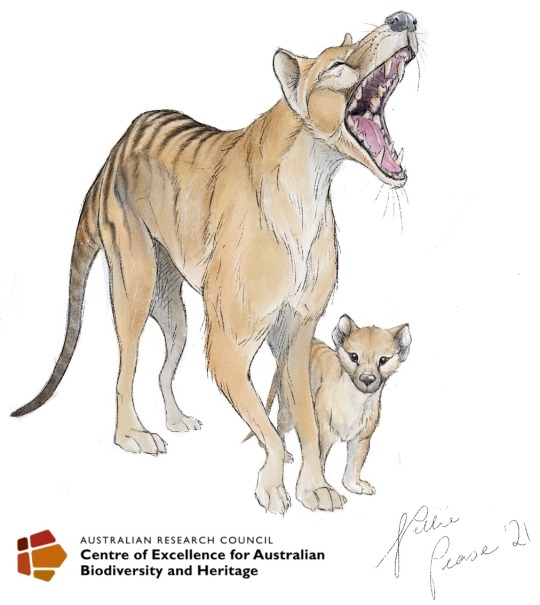
View On WordPress
#Alectura#brush turkey#Dasyurus#demographic model#Diprotodon#Dromaius#echidna#emu#extinction#Genyornis#Kangaroo#megafauna#Megalibgwilia#Metasthenurus#model#Notamacropus#Osphranter#Palorchestes#Phascolonus#Procoptodon#Protemnodon#Sahul#Sarcophilus#short-faced kangaroo#Simosthenurus#Sthenurus#Tachyglossus#Tasmanian devil#Thylacine#Thylacinus
3 notes
·
View notes
Text
Alectura lathami

By J. J. Harrison, CC BY 3.0
PLEASE SUPPORT US ON PATREON. EACH and EVERY DONATION helps to keep this blog running! Any amount, even ONE DOLLAR is APPRECIATED! IF YOU ENJOY THIS CONTENT, please CONSIDER DONATING!
Name: Alectura lathami
Status: Extant
First Described: 1824
Described By: Latham
Classification: Dinosauria, Saurischia, Eusaurischia, Theropoda, Neotheropoda, Averostra, Tetanurae, Orionides, Avetheropoda, Coelurosauria, Tyrannoraptora, Maniraptoriformes, Maniraptora, Pennaraptora, Paraves, Eumaniraptora, Averaptora, Avialae, Euavialae, Avebrevicauda, Pygostylia, Ornithothoraces, Euornithes, Ornithuromorpha, Ornithurae, Neornithes, Neognathae, Galloanserae, Pangalliformes, Galliformes, Megapodiidae
Alectura, the Australian Brushturkey, is a nonthreatened and very common Megapode found in the rainforests and scrublands of Queensland to New South Wales in Australia, as well as Kangaroo Island. It is the largest living Megapode, reaching about 75 centimeters in length with a wingspan of 85 centimeters long. These birds have black feathers all over their bodies, with red heads, and a prominent tail fan flattened against their rears that give them the superficial similarity to turkeys, hence their name (though they are not closely related besides both being types of landfowl). Like other megapodes, it has the unique trait of laying its eggs in a mound, which is built by a male and then has eggs laid in it by a variety of females he mates with. The Australian Brushturkey lays very large eggs, which hatch fully fledged young that can fly within hours of hatching, and are completely independent. There appear to be some effects of temperature on the sex of the young, like many non-avian modern reptiles, but that effect is not well known. They tend to use the same nesting sight each year. They don’t appear to be afraid of humans, and even steal human picnic food! They eat mainly insects, seeds, and fallen fruit on the ground.
Buy the author a coffee: http://ko-fi.com/kulindadromeus
Source:
https://en.wikipedia.org/wiki/Australian_brushturkey
#alectura#australian brushturkey#brushturkey#megapode#dinosaur#bird#pheasant#chicken#birblr#dinosaurs#biology#a dinosaur a day#a-dinosaur-a-day#dinosaur of the day#dinosaur-of-the-day#science#nature#factfile#Dìneasar#דינוזאור#डायनासोर#ديناصور#ডাইনোসর#risaeðla#ڈایناسور#deinosor#恐龍#恐龙#динозавр#dinosaurio
45 notes
·
View notes
Photo
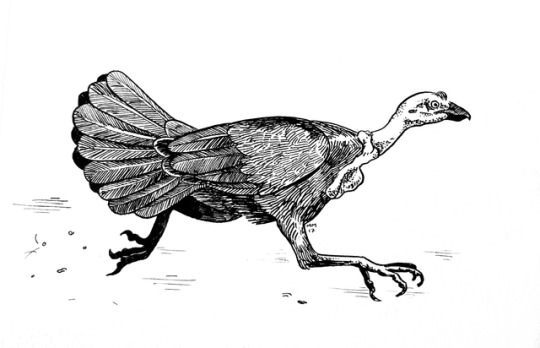
Inktober Day 11: Run
On the field site, there was an Australian Brushturkey (Alectura lathami) named Harold who would sprint across the parking lot when we looked like we were eating lunch.
#inktober#birblr art#australia#australian brushturkey#brush turkey#alectura lathami#alectura#megapodiidae#galliformes#artbysnailkites#art
102 notes
·
View notes